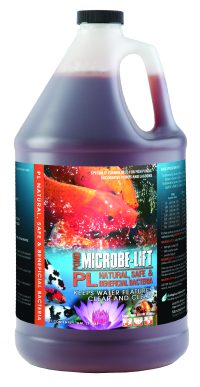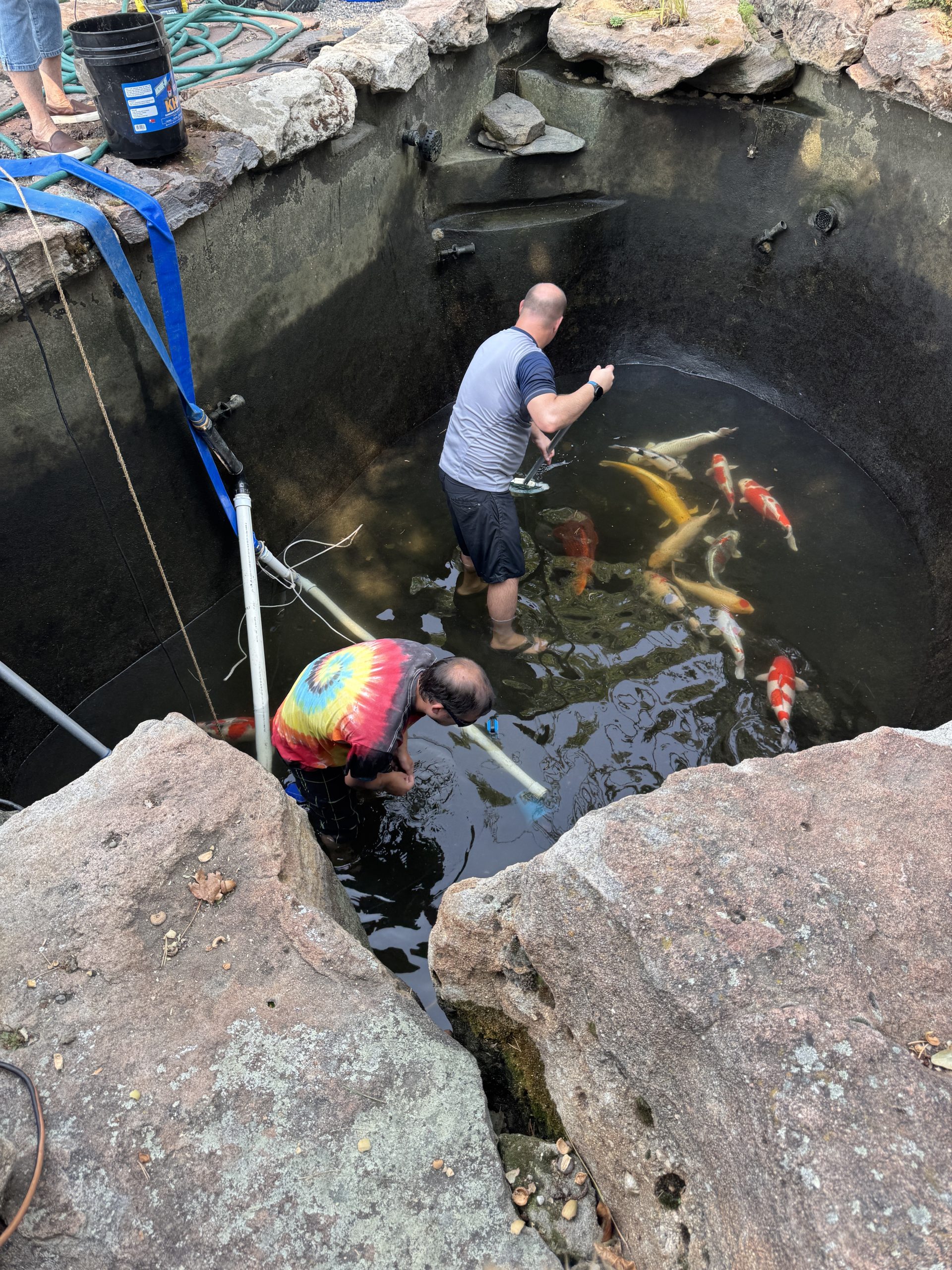MICROBE-LIFT/PL contains a novel culture consortium consisting of stable vegetative microorganisms that includes the culture classification: Phototrophs, Autotrophs, Heterotrophs and Chemotrophs.

This novel technology offers pond owners the unique capabilities to balance the pond’s ecosystem’s microbial process. Its features include a higher rate of denitrification, with the conversion of nitrate to nitrogen gas, the control of cell lyses as food supplies which are biologically oxidized and removed, & controlling the normal release of cellular-stored nutrients with indigenous biology. Combined with this, purple sulfur microorganisms control hydrogen-sulfide, achieving odor abatement in pond environments.
When considering the value of bio-remediation to wastewater process and environmental programs where biology already exists in great numbers, one must ask why add additional microorganisms to a biological system or process that has billions of active biological catalysts.
The answer to this important question considers the rate of biodegradability of the substrate within the environment, and the time that is required to biologically breakdown, oxidize and remove the matter from the environment.
Factors affecting biological processes
Few people understand that not all organic constituents “are degraded at the same-rate in terms of time”. What is important to understand is that difficult and slow-to-degrade material such as FOG and chemical agents are held on the outer cell membrane for much longer periods of time because they are much more difficult for the microorganisms to enzymatically breakdown, adsorb and convert to cellular energy (removal). The picture below shows a drawing representing how bacteria function in their slow steady process of removing organic matter via a process termed adsorption and absorption of waste organic matter.
The drawing has boxes with some boxes marked in red. The boxes represent the bacteria’s receptive sites where materials land on the cell and is then enzymatically processed. The red colored boxes provide an indication of the microbe’s cellular retention of slow- and difficult-to-degrade constituents that land on the outer cell membrane during what is termed first-stage adsorption that occurs within the biological process. The red boxes represent materials that are retained on the cells’ receptive sites due to the microorganism’s inability to enzymatically break them down to small molecules, thereby resulting in cell loading (stay on the cell).
The red boxes demonstrate what is considered the cellular loading of difficult-to-degrade matter. This means the organic matter that attaches to the cell can’t easily be enzymatically removed at the same rate as the easy-to-degrade organic matter, this is due to their degradation difficulty, and these constituents are retained on the outer cell at first-stage loading. In most cases the slow-to-degrade matter stays on the outer cell membrane affecting and slowing biological oxidation-reduction, with the materials resulting in excessive solids accumulation and the development of waste solids termed sludge.
- The use of bio-augmentation with ELI cultures has demonstrated and shown to effectively promote biomass enhancement functions and processes promoting the capability to breakdown, adsorb and absorb a far wider range of difficult- and slow-to- degrade compounds, and at a much faster rate thereby reducing or eliminating cell loading, and solids accumulation in waste removal biological processes.
- MICROBE-LIFT technology – Reduces final effluent BOD, COD, SS, improves settling in clarifiers, drives nitrification for improved ammonia removal, achieves rapid anoxic denitrification, reduces waste sludge, and biologically controls hydrogen sulfide.
It is noteworthy that the bio-enhancement process requires a period of time for the microorganisms to achieve improvement, this requires the biology to acclimate to the substrate to achieve a noted reduction of, in difficult-to-degrade matter, within the biological process.
The normal delay in biomass enhancement may be 10 to 15 days prior to achieving a noted improvement, however hydrogen sulfide reduction and odor abatement may be achieved within as little as 24 to 48 hours.
The picture below describes the biological enzymatic process to include extracellular enzyme functions at first stage necessary to break down particles attached to the outer cell membrane so they can be absorbed into the cell. In simple terms the ambient populations normally contain few organisms that have the capability of breaking down and removing modern day compounds. The diagram describes cell bound enzymatic and intracellular enzyme functions essential to organic removal, these capabilities differ within the microbial community, and most indigenous microorganisms fail to breakdown and remove difficult-to-degrade constituents. These materials end-up on the bacteria, slowing biological functions, increasing toxicity and resulting in accumulated solids.
The addition of ELI’s select vegetative microorganisms having the ability to degrade a far greater range of difficult compounds thereby reduces bio-mass toxicity, improves overall bio diversity capabilities, and results in sludge reduction. It is note-worthy that the ELI’s consortium offers microbial process and pathways that include aerobic, anaerobic, facultative and anoxic reactions assuring far greater oxidation reduction capabilities. They drive the nitrification process for ammonia removal, and promote rapid anoxic denitrification for nitrate reduction. Few if any technologies offer these capabilities.

In the above pictures the red boxes indicate retained slow- and difficult-to-degrade matter that is retained on the outer cell membrane at first stage loading, this is referred to as cell loading and results in a higher percentage of sludge build-up as the waste materials are not biologically broken-down, degraded and removed.
In the past this was often referred to as fat sludge due to the fact that most indigenous microorganisms fail to biologically breakdown and achieve a reduction in FOG, with the retained waste solids having a high percentage of FOG in the sludge, as well as in the final effluent.
The diagram below describes the biological process and its related time frame. The biological oxidation reduction process consists of: lag phase, (this is the period the microorganisms requires to identify the substrate and then produce the necessary enzyme reactions; this can vary for different substrate), Log Growth, the process where the microorganisms are responding to the substrate in cell growth, then the Stationary phase where the microorganism will develop to equal the waste matter, often referred to as the F to M ratio (food to mass). At this point you are seeing the result of the biological process in terms of good organic removal, then Death or declining phase as the microorganism decline as the food supply is reduced.

Therefore, the use of bio-augmentation with Ecological laboratories consortium will promote and assist in a more rapid development of the essential biology with the capability to breakdown and degrade slow- and difficult-to-degrade matter, reducing cell loading and sludge accumulation. However, the time frame for removal will still have to take place over a number of sludge ages.
The concept of bio-augmentation is to enhance biomass performance by assisting the indigenous microorganism in the combined capability to breakdown and remove a greater range of organic matter and at a faster rate. The information is offered to provide an understanding of the value of Bio-augmentation.
In summary, the concept of bio-augmentation is to enhance biomass performance by assisting the indigenous microorganism in the combined capability to breakdown and remove a greater range of organic matter and at a faster rate.
The information is offered to provide an understanding of the value of Bio-augmentation.
Regards
Doug Dent





